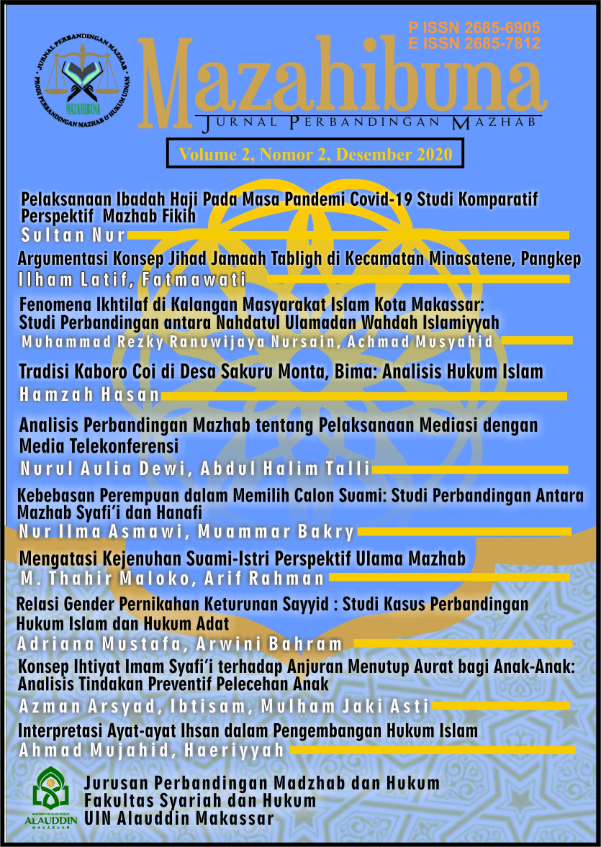Analisis Perbandingan Mazhab tentang Pelaksanaan Mediasi dengan Media Telekonferensi
Abstrak
This article seeks to present a comparison of mediation with teleconference media, both within the PERMA and the scholars of the sect. Mediation is an attempt to resolve conflicts by engaging neutral mediators who do not have the authority to make decisions that help the parties in dispute to reach a resolution or solution accepted by both parties. The multidisciplinary approach used in this article is a juridical, sociological, theological-normative and managerial approach. This article is library research, a study by writing, clarifying, and making data obtained from various written sources. The method of data collection is to use document techniques (library studies). Quoting and analyzing data with document techniques is intended to collect related data contained in documents in the form of books, journals, and research results in the form of thesis, thesis, and dissertation. The results found that the most notable differences regarding the limits of mediation with teleconference media were found in the dissent of the Sect scholars. The Shafi and Hanbali sects argue that the ideal age in marriage is 15 years, while Abu Hanfah argues that the age of maturity comes at 19 years of age for women and 17 years for men, as is the case with Imam Malik arguing that the ideal age of manhood is 18 years for both men and women. The differences between the Imams of the Sect are influenced by the environment and culture in which they live. However, in Islamic law itself there is never a very firm limit, but the most basic thing about the age limit of marriage is that it is already in placeReferensi
Dahlan, Bintang Sanusi, Pokok-Pokok Hukum Ekonomi dan Bisnis ,(Bandung: Citra Aditya Bakti, 2000)
Echol John, Hasan Shadily. Kamus Inggris Indonesia (Cet. xxv; jakarta: gramedia pustaka utama, 2003)
Hasabi M.Peradilan dan Hukum Acara Islam.(Jakarta :PT AL-Ma’arif 1984)
Hidayat Maskur, Strategi dan Taktik Mediasi Berdasarkan Perma No. 1 Tahun 2016 tentang Prosedur Mediasi di Pengadilan (Jakarta; Kencana, 2016)
Hidayat Maskur, Strategi dan Taktik Mediasi Berdasarkan Perma No. 1 Tahun 2016 tentang Prosedur Mediasi di Pengadilan (Jakarta; Kencana, 2016)
Kementrian Agama RI, Al-Qur’an dan Terjemahnya (Jakarta: CV. Penerbit Diponegoro, 2010)
M.Yahya Harahap, Hukum Acara Perdata Tentang Gugatan Persidangan,Penyitaa Pembuktian Dan Putusan Pegadilan. (Jakarta: cet II, Sinar Grafika)
Muhammad ‘Ali al- Sabuni, Rawa’i al _Bayan Tafsir ayat al – Ahkam Min al-Qur’an ,(Jakarta : Dar al – Islamiyyah)
Muhammad Ali al- Sabuni, Rawa’i al- Bayan Tafsir ayat al-Ahkam Min al-Qur’an
Muhammad bin Ahmad al- Anshari al-Qurthubi, Ahkam al- Qur’an. (Mesir ;Dar al- Kitab al- Arabi, 1967,)
Rahmadi Takdir, mediasi penyelesaian sengketa melalaui penedekatan mufakat, (Jakarta: Raja grafinda, 2011)
Soekanto Soerjono, Faktor –faktor yang Mempengaruhi Penegakkan Hukum, (Jakarta:Raja Grafindo,2007)
Soemartono Gatot, Arbitrase dan Mediasi di Indonesia, (Garmedia Pustaka Utama,Jakarta, 2006)
Soemartono Gatot, Arbitrase dan Mediasi di Indonesia, (Jakarta,Pt Garmedia Pustaka Utama,2006 )
Talli Halim Abdul,( Mediasi dalam PERMA Nomor 1 tahun 2008), Makassar ,http://journal.uinalauddin.ac.id/index.php/alqadau/article/download/2635/2486, diakses 02 Januari 2020.
Tim Penyusun Kamus Pusat Bahasa,Kamus Besar Bahasa Indonesia Edisi Ketiga, cet II,(Jakarta:Balai Pustaka,2002)
Naro, Wahyuddin, Abdul Syatar, Muhammad Majdy Amiruddin, Islamul Haq, Achmad Abubakar, and Chaerul Risal. “Shariah Assessment Toward the Prosecution of Cybercrime in Indonesia.” International Journal of Criminology and Sociology 9 (2020): 572–86. https://doi.org/https://doi.org/10.6000/1929-4409.2020.09.5.
Syatar, Abdul, and Achmad Abubakar. Filosofi ’Uqubah Islamiyah Versi Ramadhan Al-Buti; Relevansi Dengan Pemidanaan Dalam Sistem Hukum Indonesia. Gowa: Alauddin University Press, 2020.

This work is licensed under a Creative Commons Attribution 4.0 International License.
Authors who publish with Mazahibuna: Jurnal Perbandingan Mazhab agree to the following terms:
- Authors retain copyright and grant the Mazahibuna: Jurnal Perbandingan Mazhab right of first publication with the work simultaneously licensed under Creative Commons Attribution License (CC BY 4.0) that allows others to share the work with an acknowledgment of the work's authorship and initial publication in this journal.
- Authors can enter into separate, additional contractual arrangements for the non-exclusive distribution of the published version of the work (e.g., post it to an institutional repository or edit it in a book), with an acknowledgment of its initial publication in this journal.
- Authors are permitted and encouraged to post their work online (e.g., in institutional repositories or on their website) before and during the submission process, as it can lead to productive exchanges, as well as earlier and greater citation of published work.

